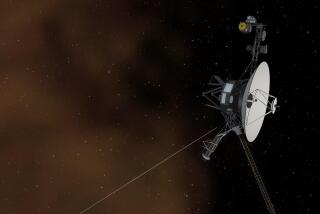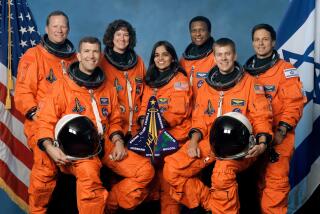Failed Space Shuttle Contact Causes Some Static Among Scouts
It was a big letdown.
Fifteen Explorer Scouts, members of a post sponsored by the Jet Propulsion Laboratory near Pasadena, were waiting to make ham radio contact with astronauts on the space shuttle Challenger when it passed overhead Thursday afternoon.
Sixteen-year-old Michelle Deets, in particular, wanted to ask whether NASA was ever going to send a teen-age girl into space. Other Scouts had different messages.
But all they heard was one brief Morse code message--and then static.
Technicians explained that it was because of a conflict in schedules: Shuttle astronaut Anthony England had planned to make the contact during his recreational time aboard the shuttle as a way of involving young people in the space program.
Deeply Involved
When the time came, however, England and others aboard the shuttle were deeply involved in experiments--no time for recreation--so about all he could do was transmit the Morse code signal, expressing regret.
“I guess everybody’s a bit disappointed,” Michelle said.
The idea to ham it up with the Scouts of Explorer Post 509 originated with England, who had requested that youth organizations around the country join with amateur radio clubs so that they could participate in the Space Amateur Radio Experiment (SAREX).
Several other youth groups, such as the Young Astronauts, Sea Scouts and Civil Air Patrol plan to try to contact the shuttle during its seven-day mission.
Although ham radio transmissions were performed during a shuttle mission last year, this is the first time that the National Aeronautics and Space Administration has made an effort to involve youths in space communication.
“This is an outstanding opportunity to really see how a space mission works from the inside,” said Stan Sander of the JPL Amateur Radio Club. “That’s an opportunity not too many young people have, and, hopefully, it will stimulate some of them to learn to do this themselves.”
Besides chatting with Challenger, the Scouts had also planned to participate in the first video transmission ever completed from Earth to a manned spacecraft. A camera focused on the Scouts’ smiling faces was to have transmitted video images to the shuttle, where England would view the picture on a 1 1/2-inch color TV screen.
Broken Image
Instead, astronauts were only able to transmit a broken image of the inside of the shuttle to the Scouts waiting below.
Paul Courson, spokesman for the American Radio Relay League in Washington, who assisted in Thursday’s attempted project, said if pictures of satellite equipment could have been transmitted to the shuttle during the April mission, astronauts might have been able to salvage a defective communications satellite.
“NASA is real keen on using the experimental nature of ham radio for their own trouble-shooting,” said Courson, who estimated that there are about 500,000 ham radio operators in the country. “We’ve been interested for a long time in improving space technology through ham radio.”
The real focus of the audio-visual experiment, however, was on youths like 16-year-old Space Explorer Scout John Hawkins.
John said the Space Exploration Post has weekly meetings with JPL employees, who describe their occupations and discuss science with the Scouts. In addition, the explorers take several field trips every year to such places as the Palomar Observatory, Yosemite Institute and Owens Valley Radio Observatory.
“Ever since the early space attempts, everyone’s been interested in space,” John said. “Nowadays, anybody can be an astronaut.”
Learned Something
Chuck Sarture, executive adviser to the Explorer post, said the JPL program was formed in 1971 to involve young people in engineering, mathematics and space exploration, and although the Scouts might have missed their only opportunity to speak to the shuttle astronauts this time, most said they still learned something from the experience.
“It just teaches you,” said 15-year-old Richard Courtright of Arcadia, “not to expect too much from outer space.”
More to Read
Sign up for Essential California
The most important California stories and recommendations in your inbox every morning.
You may occasionally receive promotional content from the Los Angeles Times.









